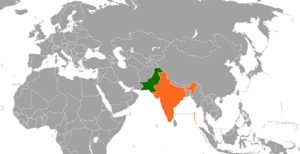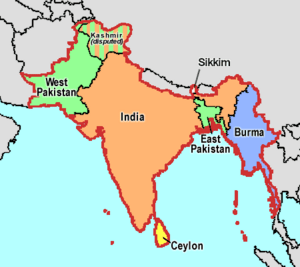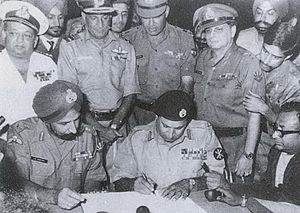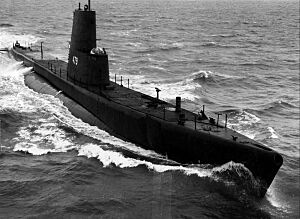Indo-Pakistani wars and conflicts facts for kids
Quick facts for kids India–Pakistan conflict |
|||||||
|---|---|---|---|---|---|---|---|
| Part of the Kashmir dispute and the Cold War | |||||||
 Location of India (orange) and Pakistan (green) |
|||||||
|
|||||||
| Belligerents | |||||||
Since the Partition of British India in 1947 and subsequent creation of the dominions of India and Pakistan, the two countries have been involved in a number of wars, conflicts, and military standoffs. A long-running dispute over Kashmir and cross-border terrorism have been the predominant cause of conflict between the two states, with the exception of the Indo-Pakistani War of 1971, which occurred as a direct result of hostilities stemming from the Bangladesh Liberation War in erstwhile East Pakistan (now Bangladesh).
Contents
Background

The Partition of India came in 1947 with the sudden grant of independence. It was the intention of those who wished for a Muslim state to have a clean partition between independent and equal "Pakistan" and "Hindustan" once independence came.
Nearly one third of the Muslim population of India remained in the new India.
Inter-communal violence between Hindus, Sikhs and Muslims resulted in between 200,000 and 2 million casualties leaving 14 million people displaced.
Princely states in India were provided with an Instrument of Accession to accede to either India or Pakistan.
Wars
Indo-Pakistani War of 1947
The war, also called the First Kashmir War, started in October 1947 when Pakistan feared that the Maharaja of the princely state of Kashmir and Jammu would accede to India. Following partition, princely states were left to choose whether to join India or Pakistan or to remain independent. Jammu and Kashmir, the largest of the princely states, had a majority Muslim population and significant fraction of Hindu population, all ruled by the Hindu Maharaja Hari Singh. Tribal Islamic forces with support from the army of Pakistan attacked and occupied parts of the princely state forcing the Maharaja to sign the Instrument of Accession of the princely state to the Dominion of India to receive Indian military aid. The UN Security Council passed Resolution 47 on 22 April 1948. The fronts solidified gradually along what came to be known as the Line of Control. A formal cease-fire was declared at 23:59 on the night of 1 January 1949. India gained control of about two-thirds of the state (Kashmir Valley, Jammu and Ladakh) whereas Pakistan gained roughly a third of Kashmir (Azad Kashmir, and Gilgit-Baltistan). The Pakistan controlled areas are collectively referred to as Pakistan administered Kashmir.
Indo-Pakistani War of 1965
This war started following Pakistan's Operation Gibraltar, which was designed to infiltrate forces into Jammu and Kashmir to precipitate an insurgency against rule by India. India retaliated by launching a full-scale military attack on West Pakistan. The seventeen-day war caused thousands of casualties on both sides and witnessed the largest engagement of armored vehicles and the largest tank battle since World War II. The hostilities between the two countries ended after a ceasefire was declared following diplomatic intervention by the Soviet Union and USA and the subsequent issuance of the Tashkent Declaration. India had the upper hand over Pakistan when the ceasefire was declared.
Indo-Pakistani War of 1971


This war was unique in the way that it did not involve the issue of Kashmir, but was rather precipitated by the crisis created by the political battle brewing in erstwhile East Pakistan (now Bangladesh) between Sheikh Mujibur Rahman, Leader of East Pakistan, and Yahya Khan and Zulfikar Ali Bhutto, leaders of West Pakistan. This would culminate in the declaration of Independence of Bangladesh from the state system of Pakistan. Following Operation Searchlight and the 1971 Bangladesh atrocities, about 10 million Bengalis in East Pakistan took refuge in neighbouring India. India intervened in the ongoing Bangladesh liberation movement. After a large scale pre-emptive strike by Pakistan, full-scale hostilities between the two countries commenced.
Pakistan attacked at several places along India's western border with Pakistan, but the Indian Army successfully held their positions. The Indian Army quickly responded to the Pakistan Army's movements in the west and made some initial gains, including capturing around 15,010 square kilometres (5,795 square miles) of Pakistani territory (land gained by India in Pakistani Kashmir, Pakistani Punjab and Sindh sectors but gifted it back to Pakistan in the Simla Agreement of 1972, as a gesture of goodwill). Within two weeks of intense fighting, Pakistani forces in East Pakistan surrendered to the joint command of Indian and Bangladeshi forces following which the People's Republic of Bangladesh was created. The war resulted in the surrender of more than 90,000 Pakistani Army troops. In the words of one Pakistani author, "Pakistan lost half its navy, a quarter of its air force and a third of its army".
Indo-Pakistani War of 1999
Commonly known as the Kargil War, this conflict between the two countries was mostly limited. During early 1999, Pakistani troops infiltrated across the Line of Control (LoC) and occupied Indian territory mostly in the Kargil district. India responded by launching a major military and diplomatic offensive to drive out the Pakistani infiltrators. Two months into the conflict, Indian troops had slowly retaken most of the ridges that were encroached by the infiltrators. According to official count, an estimated 75%–80% of the intruded area and nearly all high ground was back under Indian control. Fearing large-scale escalation in military conflict, the international community, led by the United States, increased diplomatic pressure on Pakistan to withdraw forces from remaining Indian territory. Faced with the possibility of international isolation, the already fragile Pakistani economy was weakened further. The morale of Pakistani forces after the withdrawal declined as many units of the Northern Light Infantry suffered heavy casualties. Pakistan initially did not acknowledge many of its casualties, but Nawaz Sharif later said that over 4,000 Pakistani troops were killed in the operation and that Pakistan had lost the conflict. By the end of July 1999, organized hostilities in the Kargil district had ceased. The war was a major military defeat for the Pakistani Army.
Other armed engagements
Apart from the aforementioned wars, there have been skirmishes between the two nations from time to time. Some have bordered on all-out war, while others were limited in scope. The countries were expected to fight each other in 1955 after warlike posturing on both sides, but full-scale war did not break out.
Nuclear weapons
The nuclear conflict between both countries is of passive strategic nature with nuclear doctrine of Pakistan stating a first strike policy, although the strike would only be initiated if and only if, the Pakistan Armed Forces are unable to halt an invasion (as for example in 1971 war) or a nuclear strike is launched against Pakistan, whereas India has a declared policy of no first use. According to a peer-reviewed study published in the journal Nature Food in August 2022, a nuclear war between India and Pakistan could kill more than 2 billion indirectly by starvation during a nuclear winter.
- Pokhran-I (Smiling Buddha): On 18 May 1974 India detonated an 8-kiloton nuclear device at Pokhran Test Range, becoming the first nation to become nuclear capable outside the five permanent members of United Nations Security Council as well as dragging Pakistan along with it into a nuclear arms race. Pakistani prime minister Zulfikar Ali Bhutto had promised in 1965 that "if India builds the bomb, we will eat grass or leaves, even go hungry, but we will get one of our own", and India's Pokhran-I test spurred the Pakistani nuclear weapons program to greater efforts. The Pakistan Atomic Energy Commission (PAEC) Chairman Munir Ahmed Khan said that the test would force Pakistan to test its own nuclear bomb.
- Kirana-I: In the 1980s a series of 24 different cold tests were conducted by PAEC, led by chairman Munir Ahmad Khan under extreme secrecy. The tunnels at Kirana Hills, Sargodha, are reported to have been bored after the Chagai nuclear test sites, it is widely believed that the tunnels were constructed sometime between 1979 and 1983. As in Chagai, the tunnels at Kirana Hills had been bored and then sealed and this task was also undertaken by PAEC's DTD. Later due to excessive US intelligence and satellite focus on the Kirana Hills site, it was abandoned and nuclear weapons testing was shifted to the Kala Chitta Range.
- Pokhran-II (Operation Shakti): On 11 May 1998 India detonated another five nuclear devices at Pokhran Test Range. With jubilation and large scale approval from the Indian society came International sanctions as a reaction to this test, the most vehement reaction of all coming from Pakistan. Great ire was raised in Pakistan, which issued a stern statement claiming that India was instigating a nuclear arms race in the region. Pakistan vowed to match India's nuclear capability with statements like: "We are in a headlong arms race on the subcontinent".
- Chagai-I: (Youm-e-Takbir) Within half a month of Pokhran-II, on 28 May 1998 Pakistan detonated five nuclear devices to reciprocate India in the nuclear arms race. The Pakistani public, like the Indian, reacted with a celebration and a heightened sense of nationalism for responding to India in kind and becoming the only Muslim nuclear power. The day was later given the title Youm-e-Takbir to further proclaim such.
- Chagai-II: Two days later, on 30 May 1998, Pakistan detonated a sixth nuclear device completing its own series of underground tests with this being the last the two nations have carried out to date.
Annual celebrations
The nations of South Asia observe national and armed forces-specific days which originate from conflicts between India and Pakistan as follows:
- 28 May (since 1998) as Youm-e-Takbir (The day of Greatness) in Pakistan.
- 26 July (since 1999) as Kargil Vijay Diwas (Kargil Victory Day) in India.
- 6 September (since 1965) as Defence Day (Youm-e-Difa) in Pakistan.
- 7 September (since 1965) as Air Force Day (Youm-e-Fizaya) in Pakistan.
- 8 September (since 1965) as Victory Day/Navy Day (Youm-e-Bahr'ya) in Pakistan.
- 4 December (since 1971) as Navy Day in India.
- 16 December (since 1971) as Vijay Diwas (Victory Day) in India.
- 16 December (since 1971) as Bijoy Dibosh (Victory Day) in Bangladesh.
Involvement of other nations
- The USSR remained neutral during the 1965 war and played a pivotal role in negotiating the peace agreement between India and Pakistan.
- The Soviet Union provided diplomatic and military assistance to India during the 1971 war. In response to the US and UK's deployment of the aircraft carriers USS Enterprise and HMS Eagle, Moscow sent nuclear submarines and warships with anti-ship missiles in the Arabian Sea and Indian Ocean, respectively.
- The US had not given any military aid to Pakistan in the Indo-Pakistani War of 1965.
- The United States provided diplomatic and military support to Pakistan during the 1971 war by sending USS Enterprise into the Indian Ocean.
- The United States did not support Pakistan during the Kargil War, and successfully pressured the Pakistani administration to end hostilities.
- China had helped Pakistan in various wars with diplomatic support.
- Russia maintained a non-belligerent policy for both sides. Russia helped negotiate peace in 2001–02 and helped divert the 2008 crisis.
See also
- United Nations Military Observer Group in India and Pakistan
- India–Pakistan relations
- Two-nation theory
- Patriotic hacking
- List of wars involving India
- List of wars involving Pakistan



